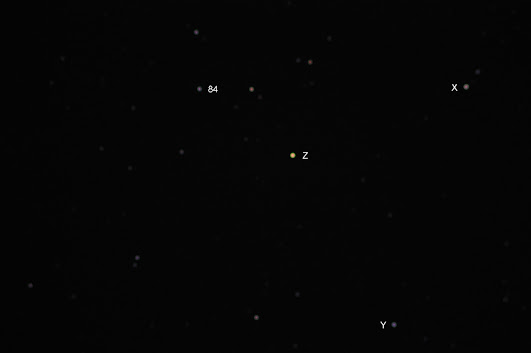I have had quite long spell of not being able to do much variable star observing (the last time was at the back end of May). The cause was the poor weather and the light evenings. This month (August) I had an opportunity to get something done on the 19th. The moon was 3 days past new and astronomical twilight ended at 21:40 UT. We had a nice clear sky but I had forgotten how hard it is sometimes to identify where a particular variable is in relation to other stars. It can take as long to refamiliarize myself with a star field as it takes to make the actual magnitude estimate.
I started with TX Draconis which I now know quite well and wasn't too difficult to find. The end two stars of Ursa Minor (Kochab and Pherkad) point to Eta Draconis and the pentangle of stars containing TX are nearby. At 22:03 UT, TX was definitely fainter than star K (at magnitude 7.0, see chart 106.04). At 22:08 UT I couldn't distinguish it in brightness from star N (magnitude 7.7). So that was my estimate. This was in good agreement with other observations by BAA members at this time.
Moving across to AH Draconis which is in the same 9 degree field, at 22:11 UT AH was fainter than star 1 (mag. 7.0) but brighter than star 6 (mag. 7.8). At 22:16 my estimate was that AH was midway between 2 and 6 in brightness, i.e. 2(1)V(1)6 or magnitude 7.6. This may be a little fainter (by 0.2 magnitudes) than other BAA estimates.
I now switched to looking at AC Herculis. This star is not so easy to find. It is located quite a way from the main asterism which forms the body of this greek hero - in fact it is better to draw a line between Delta and Beta Lyrae and continue this south and this will get you close to where AC is found. The nearest bright star is Flamsteed 109 and from there you can hop to the variable. At 22:46 I saw that AC was definitely brighter than star E (mag. 8.2 on chart 048.04) which is right next to it. At 22:48 UT I determined AC was midway in brightness between stars C (=6.9) and star D (=7.4), that is C(1)V(1)D or magnitude 7.2. This was in good agreement with other observations by BAA members.
Finally, I moved on to CH Cygni. This star has the advantage that it can be found near the outstretched wing tip of the swan asterism close to Iota and Kappa Cygni. At 23:10 CH was definitely fainter than star A (magnitude 6.5 on chart 089.04) which is very close by. It was also fainter than star W (=7.3) which is a bit further away. At 23:19 I estimated CH was similar in brightness to star D (=8.0). Again, this was in good agreement with other observations by BAA members.
All text and images © Duncan Hale-Sutton 2023







